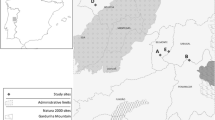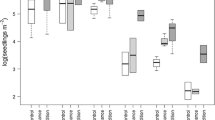Abstract
The geysers panic grass [Dichanthelium lanuginosum Spellenberg var. thermale (Bol.) Spellenberg or DILA] is exclusively associated with surface geothermal manifestations in Sonoma County, California, USA (38°46′N, 122°38′W). Steam extraction by power plants could alter the subsurface distribution of heat and water to the site, potentially impacting subpopulations of this rare plant. The purpose of this study was to use demographic monitoring to determine: (1) temporal and spatial patterns of soil temperature in relation to the distribution of established DILA individuals at Little Geysers, (2) in situ response of experimental populations of DILA to spatial variations in soil temperature, and (3) habitat requirements of DILA as an indicator of its tolerance to variations in surficial geothermal features. Thermocouple transects and a datalogger provided data for characterizing the spatial and temporal patterns of soil temperature in four microhabitats (fumarole, DILA stand, Andropogon stand, and cleared). Experimental populations were established by precisely sowing and monitoring DILA seeds in these microhabitats. The results indicated that spatial and temporal variations in soil temperature had significant effects on the processes of germination, growth, survivorship, and reproduction, thus producing a readily observed metapopulation patch dynamic in relation to geothermal activity. Seasonal depressions of soil temperature near the fumaroles by cold air and prolonged rainfall events also promoted the emergence and survival of DILA seedlings in a microhabitat that was previously too hot to occupy. Over longer periods of time, DILA metapopulation dynamism reflected climatic and geothermal variation. Drought years inhibited germination for lack of water, but more importantly for the lack of requisite soil temperature depressions in the fumarole microhabitat. Wet years promoted subpopulation expansion into transition areas that were once too hot and dry. There have also been shifts in the underground distribution of steam into areas distant from known geothermal features. The demographic responses of DILA to spatial and temporal variations in soil temperature indicate that heat is an absolutely essential component of the steam resource. In its absence, germination, seeding survivorship, growth, and maturation are significantly inhibited even if soil conditions are favorable and potential competitors are controlled. Ultimately, persistence of the species depends on maintaining the ecosystem dynamic of colonization and extirpation in response to variations in surficial geothermal features over long spatial and temporal scales. This should shift management perspective from its narrow focus on individual plants to a wider focus on monitoring the essential habitat component of steam.
Similar content being viewed by others
Author information
Authors and Affiliations
Rights and permissions
About this article
Cite this article
PAVLIK, B., ENBERG, A. Developing an Ecosystem Perspective from Experimental Monitoring Programs: I. Demographic Responses of a Rare Geothermal Grass to Soil Temperature. Environmental Management 28, 225–242 (2001). https://doi.org/10.1007/s002670010220
Issue Date:
DOI: https://doi.org/10.1007/s002670010220




